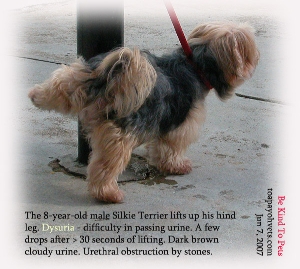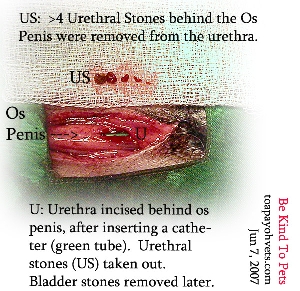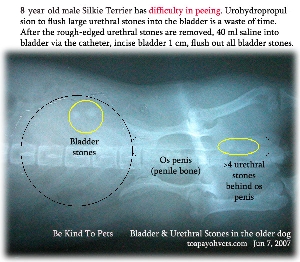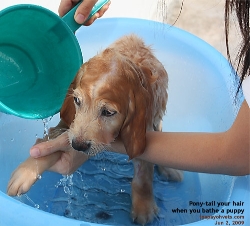|
Be Kind To Pets
educational story is to share my veterinary experiences with vets in
other parts of the world. All veterinary surgical reference books
seldom discuss the overall management of the case of urethral and
bladder stones surgery in the dog from the clinician's point of
view.

For a veterinarian, it is a happy scene to see a male dog peeing
normally within one second of leg lifting on day 6 of the surgery.
At 4 p.m on June 12, 2007 (day 6) after surgery , the Silkie
Terrier was taken out from his crate. "He prefers the grass patch
to pee," James said. The 8-year-old male dog with urethral and
bladder stone removal surgery on June 7, 2007 lifted up his left
hind leg and easily peed light yellow urine. Before surgery, he put
up his hind leg for over an eternity of several seconds with little
or no dark brown urine coming out.
Back to the beginning of the story. On Jun 7, 2007 (day 1),
8% halothane gas to quickly anaesthesize the dog. Then lower
to 2% halothane gas for maintenance. The dog was intubated
with a breathing tube into the lung. Groin area shaved. The
following procedures are briefly described.
Urohydropropulsion - Put dog on sternum. Finger inside rectum
to press on urethra. Inject via catheter 20 ml of sterile saline.
Release digital pressure. The theory is that the saline will flush
the stones into the bladder. Therefore, no need urethral surgery to
remove stones behind the os penis. With large stones (seen in
X-ray), this procedure was a waste of time. However, I tried it. It
was ineffective and I had to perform urethrotomy.
 Urethrotomy --- Insert F/8 sterile catheter into urethra. It
could not get into the bladder as the stones behind os penis blocks
it. At least 4 urethral stones were removed. 2 big stones around 3
mm in diameter blocked urethra behind the os penis (penile bone). Urethrotomy --- Insert F/8 sterile catheter into urethra. It
could not get into the bladder as the stones behind os penis blocks
it. At least 4 urethral stones were removed. 2 big stones around 3
mm in diameter blocked urethra behind the os penis (penile bone).
Urethra stitched up with 5/0 interrupted absorbable suture. Skin
then stitched up with 3/0 interrupted absorbable suture.
Cystotomy --- 40 ml saline flushed into bladder via catheter
to dilute and drain out the dark brown urine. Then more saline to
inflate the bladder. I incise 1 cm into the thick bladder wall at
its apex, ventral surface. Took the bladder out of the body as much
as possible. Thick walled. Big wide red veins on its surface
indicating that infection (cystitis) had been present for some
months. As I cut the bladder, urine and saline shot out. I made sure
that the urine shooting out did not get inside the peritoneal cavity
of the dog otherwise there will be peritonitis.
 Flushing the bladder of all debri and stones --- I clamped
the 1-cm muscle wall of the bladder. My assistant inject another 40
ml of saline via the catheter into the bladder twice. I removed the
clamp and let the urine and saline shoot outside the body. The
liquid spurted onto the floor and would have splattered onto me if
the position of the surgical site was directed at me. All bladder
stones and debri should have been flushed out from the 1 cm
incision. From the X-ray, the stones could be around 0.6 cm in
diameter. Flushing the bladder of all debri and stones --- I clamped
the 1-cm muscle wall of the bladder. My assistant inject another 40
ml of saline via the catheter into the bladder twice. I removed the
clamp and let the urine and saline shoot outside the body. The
liquid spurted onto the floor and would have splattered onto me if
the position of the surgical site was directed at me. All bladder
stones and debri should have been flushed out from the 1 cm
incision. From the X-ray, the stones could be around 0.6 cm in
diameter.
Catherisation --- Not more than 5 days are recommended. On
day 1, the catheter was pulled out by the dog from the inside out.
The 2 nylon stitches anchoring the outer end of the catheter to the
groin skin were intact. "The catheter came out from inside," my
veterinary assistant said. The Elizabeth collar had been taken out
too and the dog licked the operation areas. Blood plus urine leaked
out from the behind the os penis surgical site.
Post-op care very important --- At least 5 days
hospitalisation --- Post-operation nursing is very important as the
owner seldom knows what to do if the dog is sent home after surgery.
In this case, the catheter was pulled out by the dog. A new one was
inserted. But it was hard to get it into the bladder as the dog was
laid on his side on the operation table. What to do? Anaesthesize
the dog with gas. The urethral muscles relaxed and the catheter was
inserted. This time, sticky bandaged the catheter tip to the prepuce
and wrap the elastoplast bandage around the body.
On day 3, the elastoplast
was removed. Some blood plus urine leaked out from the prepuce. The
area was cleaned up. A bigger Elizabeth collar was used. The dog was
spoon fed with home-cooked food and given water. No dry food.
On day 5, the catheter "dropped off" as the self-adhesive bandage
wrapped round the body of the dog was not sufficient to prevent him
getting the catheter out. He was observed to pass urine normally.
Large red purple areas around his surgery site indicated attempts to
lick the whole area. I gave the dog an inflammatory injection. He
felt so much better and the redness receded by at least 50% on day
6.
For a veterinarian, it is a happy scene to see a male dog peeing
normally within one second of leg lifting on day 6 of the surgery.
At the time of this report, it was 4 p.m on day 6 after
surgery , the Silkie Terrier was taken out from his crate. "He
prefers the grass patch to pee," James said. The 8-year-old male
dog with urethral and bladder stone removal surgery on June 7, 2007
lifted up his left hind leg and easily peed light yellow urine.
Before surgery, he put up his hind leg for over an eternity of
several seconds with little or no dark brown urine coming out.
Economics --- The total cost of consultation,
anaesthesia and 2 surgeries (urethral and bladder) was S$600. X-rays
were taken by another veterinary surgery. Blood tests ought to be
done but that would add up to the cost. Prescription diet and follow
up urine analysis 3 monthly were recommended.
Owner's permission to talk to the other vet. It is always
ethical to get the permission from the owner to talk to the other
veterinarian who first saw the case. Sometimes this was ot possible
due to the personality traits of the other veterinarian. However, in
this case, the veterinarian was very helpful in giving me the
history of the case. Our paths crossed. She used to be my intern as a
20-year-old who was doing "A" levels at night. A girl who wanted to
be a veterinarian. She saw practice for a few months before she went
for her foundation studies in Kuala Lumpur and later studied
veterinary medicine in Australia. That was at least 15 - 20 years
ago. I have no doubt about her competence to do the surgery, but it
was the cost of surgery that made the owner seek me. I don't
know how much she charged but the market rate would be around $1,000
as the surgery would take as long as one hour.
She was kind enough to share her surgical
experiences about urohydropropulsion using lubricant and saline and
the surgical procedures.
Summary: Surgery takes more than one hour. Post-operation
nursing is very important as the dog tries to pull off the catheter
and will not eat or drink much. Sticky elastoplast taping of
the catheter to his prepuce was the only way to make sure that the
catheter stayed for 2 days. Needs to change after 2 days as the
bandaged area is wet with urine flow. When self-adhesive
bandage was used, the dog managed to get the catheter out.
Anti-inflammatory injection given to bring down intense itch at
operation site for this dog.
Electrolytes and antibiotics given orally for first 2 days at least.
Make sure that the Elizabeth collar is much bigger. Also check every
2 hourly. Home-cooked food needed. Make sure that he does not
take dry dog food. He was as strong dog, looking much younger
than his peers.
If you send this dog home immediately after surgery, most likely
there will be lots of problems as the urethral area stitches break
down, resulting in a hole in the urethra. Dog then leaks urine via
the urethral opening --- very unsatisfying situation for many
owners. It is preferred that the dog stays at least 14 days
but costs would be higher.
UPDATE IN 2009:
The veterinary costs can be over $2,000 and therefore many
Singapore dog owners don't bother to follow-up after treatment. In
this case, the owner did not come back for review since the surgery.
|
 TOA
PAYOH VETS
TOA
PAYOH VETS


